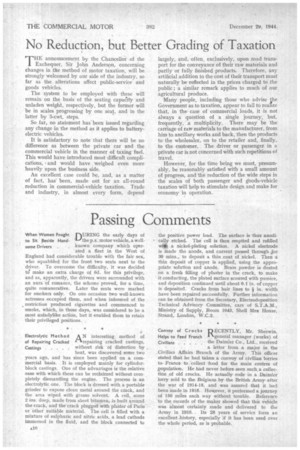Passing Comments
Page 18

Page 19

If you've noticed an error in this article please click here to report it so we can fix it.
nURING the early days of 11-‘fthe p.s: motor vehicle, a wellknown company which operated a fleet in the West of England had considerable trouble with the fair sex, who squabbled for the front two seats next to the driver. To overcome the difficulty, it was decided td' make an extra charge of 6d. for this privilege, and as, apparently, the drivers were surrounded with an aura of romance, the scheme proved, for a time, quite remunerative. Later the seats were marked for smokers only. On one occasion two well-known actresses occupied them, and when informed of the restriction produced cigarettes and commenced to smoke, which, in those days, was considered to be a most unladylike action, but it enabled them to retain their privileged positions.
When Women Fought to Sit Beside Hand some Drivers . .
Electrolytic Method A N interesting method of of Repairing Cracked r-Irepairing cracked castings,
Castings without risk of distortion by , heat, was discovered some two years ago, and has since been applied on a commercial basis. It is employed mainly for cylinderblock castings. One of the advantages is the relative ease with which these can be reclaimed without completely dismantling the engine. The process is an electrolytic one. The block is dressed with a portable grinder to expose clean metal around the crack, and the area wiped with grease solvent. A cell, some 2 ins, deep, made from sheet bitumen, is built around the crack, and the crack plugged with plaster of Paris or other suitable material. The cell is filled with a mixture of sulphuric and nitric acids, a lead cathode immersed in the fluid, and the block connected to the positive power lead. The surface is thus anodically etched. The cell is then emptied and refilled villb a nickel-plating solution. A nickel electrode is made the anode, and current passed through or 30 ruins., to deposit a thin coat of nickel. Then a thin deposit of copper is applied, using the appropriate solution and anode. Brass powder is dusted on a fresh filling of plaster in the crack, to make it conducting, the plated surface scoured with pumice, and deposition continued until about 0.1 in. of copper is deposited: Cracks from hair lines to it in. width have been repaired successfully. Further information can be obtained from the Secretary, Electrodeposition Technical Advisory Committee, care of S.T.A.M., Ministry of Supply, Room 1043, Shell Mex House, Strand, London, W.C.2.
RECENTLY, Mr. Sherwin, Vgeneral manager (works) of the Daimler Co., Ltd., received a letter from a major in the Civilian Affairs Branch of the Army. This officer stated that he had taken a convoy of civilian lorries to France to collect food for the main centres of population. He had never before seen such, a collection of old crocks. He actually rode in a Daimler lorry sold to the Belgians by the British Army after the war of 1914-18, and was assured that it had been made in 1916. However, it performed a journey of 150 miles each way without trouble. Reference to the records of the maker showed that this vehicle was almost certainly made and delivered to the Army in 1916. Its 28 years of service form an excellent -history, especially if it has been used over the whole period, as is probable.
Convoy of Crocks Helps to Feed French
Civilians
WRITING from Taber, WV Alberta, Canada, a transport operator tells us that he is lasing the costing system which has been frequently outlined in this journal, and says " I think it grand." He has shown it to several other operators, who will probably change their's accordingly. Incidentally, he asks for two of " The Commercial Motor" Tables of Operating Costs. He receives safely most of his copies, although sometimes several weeks elapse between deliveries. Concerning this, he remarks: " But then there is a war on. although one is hardly conscious of it on the Western Prairies; it all seems very remote." He adds that the journal is much enjoyed by himself and his employees, for to them it is something quite novel, there being nothing like it published in Canada. He wonders why we do not make much more use in England of articulated outfits, which, in Canada, they term semitrailers. He imagines that they would have a smaller Canadian Views on This Journal and
Transport
unladen weight for the higher loads than the eightwheelers so much employed, although, perhaps, the stability would not be so good on wet or greasy highways: Those in his part of Canada are mostly of the gravelled type.
East Africans Are Spellbound at Vehicle
Pictures . .
A' applicant for inclusion in our Service Index for postwar employment is in the
He says that be receives " The Commercial Motor" fairly regularly from his father-in-law. What interests us particularly, however, is to learn that his drivers, who are East Africans and cannot read English, are, to use his own words, " spellbound at the illustrations of ' tomman gharries,' " which African term means big trucks, etc. We hope that East Africans and other nationals will be still more surprised when this journal is published in full size with more illustrations and improvements in the post-war days.




















































